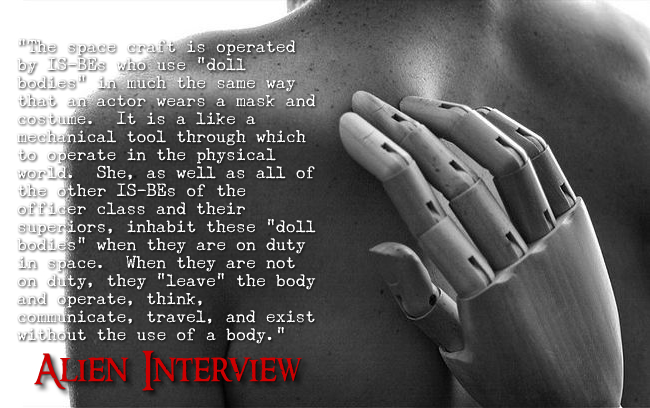 “The space craft is operated by IS-BEs who use “doll bodies” in much the same way that an actor wears a mask and costume. It is a like a mechanical tool through which to operate in the physical world. She, as well as all of the other IS-BEs of the officer class and their superiors, inhabit these “doll bodies” when they are on duty in space. When they are not on duty, they “leave” the body and operate, think, communicate, travel, and exist without the use of a body.
“The space craft is operated by IS-BEs who use “doll bodies” in much the same way that an actor wears a mask and costume. It is a like a mechanical tool through which to operate in the physical world. She, as well as all of the other IS-BEs of the officer class and their superiors, inhabit these “doll bodies” when they are on duty in space. When they are not on duty, they “leave” the body and operate, think, communicate, travel, and exist without the use of a body.
The bodies are constructed of synthetic materials, including a very sensitive electrical nervous system, to which each IS-BE adjusts themselves or “tune in” to an electronic wavelength [i] (Footnote) that is matched uniquely to the wavelength or frequency emitted by each IS-BE. Each IS-BE is capable of creating a unique wave frequency which identifies them, much like a radio signal frequency. This serves, in part, as identification like a finger print. The doll body acts like a radio receiver for the IS-BE. No two frequencies or doll bodies are exactly the same.
The bodies of each IS-BE crew member are likewise tuned into and connected to the “nervous system” built into the space craft. The space craft is built in much the same way as the doll body. It is adjusted specifically to the frequency of each IS-BE crew member. Therefore, the craft can be operated by the “thoughts” or energy emitted by the IS-BE. It is really a very simple, direct control system. So, there are no complicated controls or navigation equipment on board the space craft. They operate as an extension of the IS-BE.
When the lightning bolt struck the space craft this caused a short circuit and consequently “disconnected” them from the control of the ship momentarily which resulted in the crash.
Airl was, and still is, an officer, pilot and engineer in an expeditionary force which is part of a space opera [ii] (Footnote)civilization which refers to itself as “The Domain”. This civilization controls a vast number of galaxies, stars, planets, moons and asteroids throughout an area of space that is approximately one-fourth of the entire physical universe! The continuing mission of her organization is to “Secure, control and expand the territory and resources of The Domain”.”
— Excerpt from the Top Secret transcripts published in the book ALIEN INTERVIEW
FOOTNOTES:
[i] …”electronic wavelength”…
“In physics, wavelength is the distance between repeating units of a propagating wave of a given frequency. It is commonly designated by the Greek letter lambda (λ). Examples of wave-like phenomena are light, water waves, and sound waves. In a wave, a property varies with the position. For example, this property can be the air pressure for a sound wave, or the magnitude of the electric or the magnetic field for light. The wavelengths of frequencies audible to the human ear (20 Hz–20 kHz) are between approximately 17 m and 17 mm, respectively. Visible light ranges from deep red, roughly 700 nm to violet, roughly 400 nm (430–750 THz). For other examples, see electromagnetic spectrum.”
— Reference: Wikipedia.org
[ii] …”space opera” civilization”…
“It was not until the 1920s that the space opera proper appeared in the pulp magazines Weird Tales and Amazing Stories. Unlike earlier stories of space adventure, which either related the invasion of Earth by extraterrestrials, or concentrated on the invention of a space vehicle by a genius inventor, pure space opera simply took space travel for granted (usually by setting the story in the far future), skipped the preliminaries, and launched straight into tales of derring-do among the stars.
The first stories of this type were J. Schlossel’s The Second Swarm (Spring 1928) in Amazing Stories Quarterly and Edmond Hamilton’s Crashing Suns (August-September 1928) and The Star Stealers (February 1929) in Weird Tales . Similar stories by other writers followed through 1929 and 1930; by 1931 the space opera was well-established as a dominant sub-genre of science fiction.
The transition from the older space-voyage story to the space opera can be seen in the works of E. E. “Doc” Smith. His first published work, The Skylark of Space (August-October 1928, Amazing Stories), merges the traditional tale of a scientist inventing a space-drive with planetary romance in the style of Edgar Rice Burroughs; but by the time of the sequel, Skylark Three (August-October 1930, Amazing Stories) which introduces the space faring race of the Fenachrone, Smith had moved closer to a space opera mode.
Space opera in its most familiar form was a product of 1930s-40s pulp magazines. Like early science fiction in general, space opera borrowed much of its style from established adventure, crime, and thriller genres. Notable influences included stories that described adventures on exotic or uncivilized frontiers, e.g. the American West, Africa, or the Orient. The imagined future of space opera included immense space liners, intrepid explorers of unknown worlds, pirates of the space ways, and tough but incorruptible space police.
E. E. “Doc” Smith’s later Lensman Series and the works of Edmond Hamilton, John W. Campbell, and Jack Williamson in the 1930s and 1940s were popular with readers and much imitated by other writers. By the early 1940s, the repetitiousness and extravagance of some of these stories led to objections from some fans.”
— Reference: Wikipedia.org
Originally posted 2012-05-09 23:58:56. Republished by Blog Post Promoter

